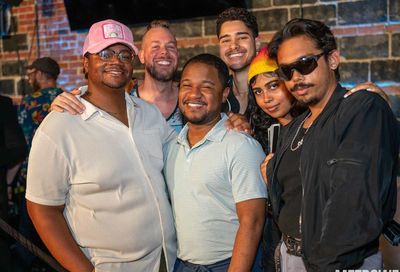Everyone's a little gay, sometimes
Prop 8 defenders argue that ''gay'' is something anyone can be, not a distinct and unchangeable identity
SAN FRANCISCO – The legal team defending California’s ban on same-sex marriages is in the very odd position of having to argue that most people – including heterosexuals – feel an attraction to people of the same sex at some time in their lives. They must argue that there’s no sharp line between heterosexuality and homosexuality, and that the image any person might have of a ”mate” can be ”infinitely variable.”
These are not the sorts of ideas put forth by the Yes on 8 campaign in 2008, when it sought passage of Proposition 8, to amend the state constitution to define marriage as including only ”one man and one woman.” But the battle has moved from the political arena – where the general public can be swayed by appeals to numerous emotions — to the legal arena, where judges must scrutinize the logic and reasonableness of various arguments.
And one of the things U.S. District Court Chief Judge Vaughn Walker must decide is whether Proposition 8 targets a ”discrete” and ”insular” minority whose members share an immutable trait, have experienced a long history of discrimination, and are politically powerless to protect themselves. If Judge Walker decides that gays constitute such a minority, he must then determine whether there is, rather than just a simple reason that barely passes a giggle test, but a compelling need for Proposition 8 to disadvantage gays.
And that’s why defense attorney Howard Nielson spent most of the day Friday trying to elicit testimony from the plaintiffs’ expert witness, social psychologist Gregory Herek, acknowledging that it’s ”not immediately evident” that a person is gay ”from simply looking at a person.”
Nielson read from journal articles saying there were ”heated debates” among professionals about how to identify a person’s sexual orientation. He quoted articles that noted a person who might identify as straight at one point in their life might identify as gay later in life. And he asked Herek about a study suggesting that between one percent and 21 percent of people are ”gay or lesbian to some degree, while the rest are heterosexual or bisexual to some degree.”
Nielson brought up the studies of Alfred Kinsey from the 1940s and 50s that suggested everyone’s sexual orientation falls along a continuum from exclusively heterosexual to exclusively homosexual. And he quoted another researcher as saying, ”nearly all heterosexual people are capable of some homosexual response and nearly all homosexuals are capable of some heterosexual response…and hence no sharp line distinguishes between homosexuality and heterosexuality.”
Like other expert witnesses brought by the plaintiffs thus far, Herek was not particularly vulnerable to taking bait. When Nielson asked him whether he agreed that every heterosexual was capable of some homosexual response, Herek replied that it would be important to define what one means by ”capable.”
”If it means ‘theoretically possible,”’ said Herek, ”I could certainly allow that that seems like a reasonable assumption to make, but I don’t know what data [the researcher] is relying on to make that statement.” He said the other terms, too, would have to be defined, such as what is a ”heterosexual response.”
”Would you agree there is no stark line between homosexuality and heterosexuality?” asked Nielson.
The key, again, said Herek, would be how one defines the terms homosexuality and heterosexuality.
When Nielson pointed out that different researchers use different definitions of sexual orientation for their studies, Herek explained that different studies often required very specific – and different — definitions in order to tease out the particular information for which they are looking.
”If a researcher is studying sexually transmitted diseases, they would probably want a definition that focuses on sexual behavior,” said Herek. ”If they were studying discrimination, they might want a definition that focuses on sexual identity.”
Nielson’s cross-examination, like that of several other defense attorneys, seemed unusually tedious and prolonged and included a repetitive sequence in which he plucked one sentence out of an article to get Herek’s to say whether he thought the comment was ”reasonable.” Each time, Herek – without missing a beat — responded by reading the sentences before or after the plucked statement in order to show the comment’s context. That often demonstrated that the researcher was making a point somewhat different than the one Nielson’s chosen statement seemed to be asserting.
Then Nielson would ask Herek the reverse: Was the original statement ”unreasonable”?
During his questioning by plaintiffs’ attorney Ethan Dettmer, Herek identified sexual orientation as ”an enduring sexual, romantic…and affectionate attraction to men, women, or both.” The ”enduring” designation is important because it supports the notion that sexual orientation for gay people is ”immutable.”
Herek discussed the results of two recent studies he helped conduct – one published in the Journal of Counseling Psychology this year and one accepted for publication in another journal, but not yet published. The studies asked gay and bisexual people ”how much choice they had” about being gay, lesbian, or bisexual. The first study, which involved 2,200 people, found that 87 percent of gay men and 70 percent of lesbians said they felt they had no or little choice.
Dettmer also asked Herek to offer his understanding of reparative therapy, another question aimed at establishing that sexual orientation is immutable. Herek testified about a 2009 study from a American Psychological Association task force that found available studies have found reparative therapy to have ”very limited effect” and to be potentially harmful to its participants.
There was, said the report, ”insufficient evidence to support use of psychological interventions to change sexual orientation.”
With attorneys on both sides, the process of reading aloud quotes and data from various articles and exhibits bound together in four-inch black loose-leaf binders is de rigueur. But the seemingly endless number of quotes and studies being reviewed by the defense has provoked grumbles from both the judge and the audience watching in the courtroom. Often, the audience lets out an audible moan when an attorney approaches the podium carrying a large stack of binders or an assistant enters the courtroom rolling in a pile of boxes filled with binders. The courtroom is a virtual sea of black binders – so many, in fact, that there is a temporary, long, metal bookshelf erected next to the plaintiff attorneys’ table with three rows of binders on it — more than 50.
After black binders, the most common site in the courtroom is the abundance of black laptops – one in front of every attorney (and none of them are Macs).
There is an occasional surprise in the generally staid and repetitive proceeding, and on Friday, it came at the beginning: a surprise announcement by Judge Walker that he would delay the delivery of closing arguments in the case until at least several weeks after all the evidence has been presented.
”Given the volume of material” being introduced into evidence in the lawsuit, said Walker, he thinks it would be ”much more productive and useful if I have a chance to tease out some questions.”
Friday was Day 10 of the historic trial to determine whether the California state constitutional ban on same-sex marriage violates the U.S. Constitution’s guarantee of equal protection of the law.
Herek, who was today’s first and only witness, is also the last witness which attorneys challenging Proposition 8 plan to bring to the witness stand. On Monday, they plan to introduce a number of documents into evidence, and then the case swings to the legal team presenting a defense of Proposition 8. The defense has already indicated it is withdrawing most of its original witnesses but they indicated in court Friday afternoon that they would bring two or three witnesses to the stand next week.
© 2010 by Keen News Service. All rights reserved.
Support Metro Weekly’s Journalism
These are challenging times for news organizations. And yet it’s crucial we stay active and provide vital resources and information to both our local readers and the world. So won’t you please take a moment and consider supporting Metro Weekly with a membership? For as little as $5 a month, you can help ensure Metro Weekly magazine and MetroWeekly.com remain free, viable resources as we provide the best, most diverse, culturally-resonant LGBTQ coverage in both the D.C. region and around the world. Memberships come with exclusive perks and discounts, your own personal digital delivery of each week’s magazine (and an archive), access to our Member's Lounge when it launches this fall, and exclusive members-only items like Metro Weekly Membership Mugs and Tote Bags! Check out all our membership levels here and please join us today!


























